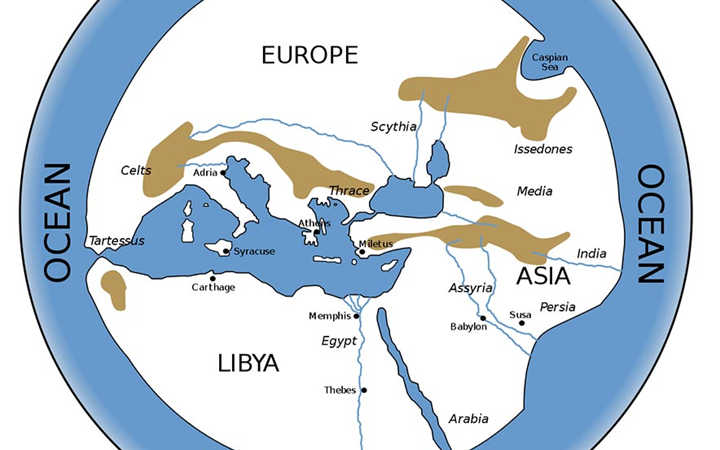Since the name of this site is GrecoMAP, it might be fitting to delve into the phenomenon of mapmaking. As is the case in so many other disciplines, it was the Greeks who effectively got there first with respect to a coherent geography.
While the Greeks cannot claim to be the first mapmakers, they can lay claim to the first attempt to realistically map the world.
The Babylonians had a go at this. Their map, found on a small clay tablet 12.2cm tall and 8.2cm wide (about 5 x 3 inches), is almost certainly part of a much larger tablet, with some of the cuneiform script on this particular fragment translatable from script on the front, and on the back as well:
As you can see, the map is very rudimentary, with little knowledge of the earth beyond the edge of the very extensive Babylonian Empire. While no precise dating is possible, it almost certainly predates the first Greek-produced map of the world, which was drawn in the latter part of the 6th century, BC. The Babylonian map shows a wide vertical rectangle representing the Euphrates, which empties into a rectangular channel which may be a bypass to the swamps found in that region. The channel then appears to empty into the Persian Gulf. Near the top is the large rectangle representing Babylon, with surrounding mountains, cities and empires.
The map shows how little the Babylonians knew about the world around them. This is probably because they were a land power, with little or no sea trade. On the other hand, as you can see by the reconstruction below, first Greek map of the world is much more complete and accurate, probably thanks to an active Greek trading culture in the Mediterranean and Black Seas:
Interestingly, both maps have a sea encircling their land masses. This map could be as close, chronologically, to the Babylonian map (which is hard to date) as a hundred years, or it could be several hundred years later.
Anaximander and Hecataeus
Two figures are responsible for the more complete view of the world by the ancient Greeks: The first man was the pre-Socratic philosopher Anaximander of Miletus, Asia Minor (Miletus is one of the Ionian cities on the western fringes of modern-day Turkey, where a Greek presence went back to around 1,000 BC). The second man is known as the “father of geography,” Hecataeus, who drew that first map of the world (which in reality is an improvement on an original map by Anaximander).
Hecataeus was only four years old when Anaximander died in 546 BC, so they didn’t know each other beyond the very remote possibility that Anaximander stopped by Hecataeus’ house for a visit and patted the toddler on his head.
The philosopher Anaximander was fascinated with scientific explanations for the origins of the universe. Thus his interests crossed over into other disciplines than pure philosophy. A lot of the classic philosophers did this. No specialists they, they were walking inquiring minds, and probably would spend most of their lives in front of a computer screen had they lived today. Pursuant to his interest in origins, Hecataeus delved into astronomy, attempting to understand the mechanics of celestial bodies.
Anaximander was the first to postulate that the earth floated freely on what was known as the “infinite,” a substance different from the four elements of fire, earth, air and water. His idea of the earth being disc-shaped was borrowed from Thales, a contemporary of Anaximander’s, who also believed the earth was floating-, but on water. Anaximander’s visionary idea that the earth was suspended was, according to Aristotle, “ingenious.”
Now contrast the concept of a floating earth with the ancient Hindu belief that the world was held up by four elephants, who stood on the back of a turtle, who stood on the back of another turtle, etc., etc., etc., with there being “turtles all the way down.” This is the concept of infinite regression, and is more in harmony with mythology than science. These pre-Socratics were the first to break with mythological explanations of origins, and to pursue a purely scientific study of origins.
Anaximander was then able to imagine the earth as being in the center of infinite space, removing the possibility of there being any “down” to fall towards (or “up” for that matter).
This idea of a free-floating earth is considered the first revolutionary cosmological idea, and the true beginning of scientific thought.
Hecataeus, who died in 476 BC, and thus lived through the Greco-Persian wars (Marathon was fought in 480), travelled far and wide as a younger man, and then re-settled in Miletus, where he had a high position in local government, and spent a lot of time composing geographical and historical texts. He was the first classical writer to mention the Celtic and Illyrian peoples. (Illyria was Albania, and on up the Adriatic coast). He was also part of a committee sent to the Persian satrap Artaphernes after the surrender of Miletus to Persia in 494 BC, successfully suing for the restoration of the constitutions of the cities of Ionia.
This “father of geography” is known for his two works, World Survey (Περίοδος γής) and Geneologia (Γενεαλογία), or Historia (Ιστορία). He was the first to write in prose, whereas Homer’s oral tradition was in the form of poetry. Hecataeus distrusted oral history. And, as has been mentioned, he improved Anaximander’s map of the known world.
Herodotus (485-420 BC) considered the father of history, represents the culmination of his predecessors Anaximander and Hecataeus, in that, in his The Histories, he presents the fullest exposition to date of the world’s geography. One can draw a pretty accurate map from his detailed description.
Herodotus’ description of the “Oikoumene,” the inhabited world, yields a map that looks like this:
This map is of course very similar to that of Anaximander/Hecataeus, and even resembles in a broad sense that of the Babylonians, with its three continents surrounded by a great ocean, except he allows for some theorizing as to what lay to the far north and the far east. The details Herodotus provides are, for the most part, thanks to his extensive travels and detailed note-taking. He maps and names several rivers and mountain ranges which were not provided in previous maps.
Building upon generational increases in knowledge of the world, we finally come to Eratosthenes (276-195 BC), the Hellenistic Age astronomer, geographer, mathematician and poet, who was the first to calculate the circumference of the earth, and the tilt of its axis, both remarkable achievements for that age.
Eratosthenes was, for a time, the curator of the Library of Alexandria, one of the 7 wonders of the ancient world. He wrote a three-volume Geography, and is the first to use the term. He was a contemporary and friend of Archimedes, famous for saying “Give me a place to stand, and a lever long enough, and I’ll move the world.” The two men encouraged and helped each other in their work.
The work of these ancient Greeks in the field of geography is a reflection on their intellectual curiosity and brilliant insights. We’re the direct beneficiaries of their research, which, in a sense, finds its culmination in Google Earth, which has mapped virtually every square foot of the planet, and almost all streets of the world. If your desire is to come to almost any place in Greece, Google Earth will give you an unvarnished view of that place, in addition to the beautiful photography provided from other sources, including this site.
















